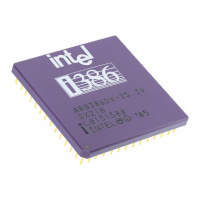80960KB
6
Figure 4. Multiple Register Sets Are Stored On-Chip
REGISTER
CACHE
ONE OF FOUR
LOCAL
REGISTER SETS
LOCAL REGISTER SET
R
15
R
0
31
0
1.1.7 Floating-Point Arithmetic
In the 80960KB, floating-point arithmetic has been
made an integral part of the architecture. Having the
floating-point unit integrated on-chip provides two
advantages. First, it improves the performance of the
chip for floating-point applications, since no
additional bus overhead is associated with
floating-point calculations, thereby leaving more time
for other bus operations such as I/O. Second, the
cost of using floating-point operations is reduced
because a separate coprocessor chip is not
required.
The 80960KB floating-point (real-number) data types
include single-precision (32-bit), double-precision
(64-bit) and extended precision (80-bit) floating-point
numbers. Any registers may be used to execute
floating-point operations.
The processor provides hardware support for both
mandatory and recommended portions of IEEE
Standard 754 for floating-point arithmetic, including
all arithmetic, exponential, logarithmic and other
transcendental functions. Table 3 shows execution
times for some representative instructions.
1.1.8 High Bandwidth Local Bus
The 80960KB CPU resides on a high-bandwidth
address/data bus known as the local bus (L-Bus).
The L-Bus provides a direct communication path
between the processor and the memory and I/O
subsystem interfaces. The processor uses the L-Bus
to fetch instructions, manipulate memory and
respond to interrupts. L-Bus features include:
• 32-bit multiplexed address/data path
• Four-word burst capability which allows transfers
from 1 to 16 bytes at a time
• High bandwidth reads and writes with
66.7 MBytes/s burst (at 25 MHz)
Table 4 defines L-bus signal names and functions;
Table 5 defines other component-support signals
such as interrupt lines.
Table 3. Sample Floating-Point Execution Times
(µs) at 25 MHz
Function 32-Bit 64-Bit
Add 0.4 0.5
Subtract 0.4 0.5
Multiply 0.7 1.3
Divide 1.3 2.9
Square Root 3.7 3.9
Arctangent 10.1 13.1
Exponent 11.3 12.5
Sine 15.2 16.6
Cosine 15.2 16.6

